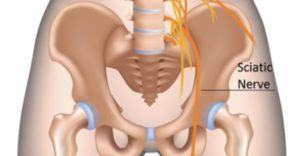Sciatica, what is it and what should you do?

Sciatica pain is debilitating, and one of the number one reasons that people seek care in my office. It is one of those conditions that is easy to self-diagnose and is extremely common. The sciatic nerve is the largest nerve in the body, and it begins in the lower back and travels through the buttocks, down the thigh, and then branches to the knee, feet, and toes. It actually begins with three nerve roots that leave the spinal cord through little holes in the spine and then bundles together to form the sciatic nerve. That can be very helpful in diagnosis, since those nerve roots supply different parts of the leg and foot. For instance, if the L4 nerve root is getting pinched bad enough, you may feel pain, numbness, tingling, and burning down the inside of your lower leg to your big toe.
The nerve roots can be pinched by a few things, but the most common are:
- Facet joint inflammation
- Disc bulge or herniation
- Canal stenosis from arthritis
The sciatic nerve bundle may also get pinched in the buttock area by a muscle called piriformis, which runs from the tailbone to the hip bone. Because the nerve runs right under or actually directly through the piriformis, tightness and/or inflammation of this muscle can compress the sciatic nerve. This is the most common cause of sciatica in pregnant women.
What To Do?
The first thing to do is to get checked by a chiropractor. Chiropractors are thoroughly trained in diagnosing spinal pain and sciatica. Based on symptoms, range of motion, and orthopedic/neurological testing, we can usually pinpoint the primary cause of the nerve pinching. With severe findings, an MRI might be necessary right away.
After you have a diagnosis, and follow your doctor’s initial recommendations, there are things you can do at home to reduce the inflammation and pinching. Just remember that all backs are different, and all conditions are different. Be careful of friends and family that mean well, but will sometimes recommend inappropriate stretches, exercises etc. They may also inadvertently compare or minimize your condition.
Having this problem does not have to be a drastic situation. Most studies suggest that less than 1% of people with sciatica will need surgery. While another small percentage might need more invasive therapies such as injections and ablasions, most sciatica conditions can be resolved with a variety of conservative treatments. In my office, we see excellent results with our combination of chiropractic, laser therapy, stretches, and exercises.
Get checked, get a plan, and get back to your pain-free life!
Here for you always,
Kent Owens, DC
